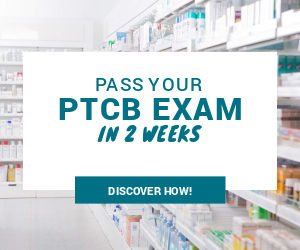The idea of computing and solving PTCB math problems might come as a surprise to a pharmacy technician, but these are some of the basic functions that come with the job. However, the classification of calculations for numerous situations may differ, but understanding algebra is important to become a pharmacy technician.
And the basic use of algebra and complex dimensional analysis are thoroughly implemented by pharmacy technicians to calculate prescribed doses.
The fact of the matter is that pharmacy technicians, more or less, convert one system of measurement to another, which ultimately determines the dosage period and calculation.
Basic PTCB Math Problems
Well, one of the most common types of question a pharmacy technician could get in their PTCB math exam is finding out the correct transcription of prescribed tablets that a patient is required to take.
And if the prescribed tablet is just one, then the dose would be one tablet for a day.
Another PTCB math problem may involve calculating the appropriate dosage for a patient who is to receive 100 mg/m2 of docetaxel and roughly weighs 175 pounds with a body surface area of 1.8 meter square. And since the weight is already included in a patient’s BSA, the answer is 1.82 m2 x 100 mg per meter square for 180 mg.
In hindsight, a pharmacy technician should also have the basic analytical mind to calculate a patient’s weight and height to reach a specific dosage.
Also, pharmacy technicians should be familiar with calculating dosages in milliliters. A question may involve asking how many milliliters of an oral solution (10mg/mL) you should dispense for a patient that requires just 2 teaspoonfuls, 3 times daily for seven days.
First and foremost, establish that two tablespoons are roughly 10 mL. And 10 mL 3 times daily for seven days equals to 210 mL.
The math problem above is quite common for a retail pharmacy technician and could apply in a hospital setting as well.
The Use of Proportional Math
Proportional math is one of the most effective and easiest methods to solve pharmaceutical calculations. Moreover, proportional math is applied to solve dosage problems in both retail and hospital settings.
A pharmacy technician makes use of proportional math to calculate the volume of a dosage prescribed to a patient.
Complex dosage divisions and sub-divisions could easily be solved with the help of proportional math.
For example, how much sterile water will have to be used to dilute 1 L of 70 percent alcohol present to a 40 percent solution? And how much 40 percent solution will you make?
You could easily solve the problem by multiplying 1000 x 70 and dividing with 100 to get the value of X. And as for the solution itself that contains about 700 ml of alcohol; you can multiple the alcohol with solution present (700 x 100 / 40) to get 1750 of total amount diluted solution. Also, to get the solution, add 750 ml of sterile water.
However, remember that concentrations may represent the ratio of ingredients or the entire percentage. To indicate ratios to the solute, drug or solvent; V/V, W/W, and W/V are used in concentrations.
Keep in mind that the proportion method is used only to find out the fourth unknown X factor.
Other PTCB Math Practices
A pharmacy technician, however, would have to undertake more advanced calculations when it comes to body weight, percentage, ratio solutions, and surface area calculations.
Whether a pharmacy technician is working in a hospital setting or at a retail store they will have to acquire advance math skills necessary to comply with necessary job responsibilities in today’s health care industry.
Also, pharmacy technicians are sometimes required to learn business math skills to excel at their job. And learning algebra from a reputable school wouldn’t hurt. Furthermore, it would be an oversight if computer skills necessary to operate in today’s health care industry were overlooked.
Most of the pharmacy technicians use and sometimes rely on computers to solve complicated algorithm data, yet they still rely upon their skills to get a pharmacy technician certification in the first place.
Overcoming Your Fear of Math
Many pharmacy technicians develop math phobia, which is a severe form of math anxiety. Moreover, it is vital that pharmacy technicians see math anxiety as an emotional issue instead of an intellectual one.
A majority of pharmacy technicians need to realize the fact that they can easily face math anxiety or phobia.
The fact of the matter is that math operates on a continuous string of complex chain and once you leave something out, the mechanism of the chain would be weak.
Self-Assessment
You could open several doors once you get over their anxiety to experience math as an exciting and interesting tool to be more immersive in the world.
Also, you shouldn’t try to mirror your worst fears and anxiety of math problems on someone else who may be experiencing the same issue.
Some errors may reappear over time, but that doesn’t mean you shouldn’t make a comprehensive plan to sharpen your skills, do research, and overcome math anxiety.
Need help preparing for your PTCB

What You Can Earn as a PTCB-Certified Technician in 2024
As of April 27, 2019, the average hourly wage for a pharmacy technician in the United States is between $15

Pharmacy Technician Requirements By State
If you want to work as a pharmacy technician, you’ll need to understand what the requirements are for your state

Pharmacy Licensure vs. Certification: What You Need to Know
One of the questions we get all the time is regarding the differences between licensure and certification. Let’s have a

2020 PTCB Certification Changes | Everything You Need to Know
The Pharmacy Technician Certified Board (“PTCB”) exam can be one of the most significant obstacles preventing you from achieving your

PTCB Math: How to Pass | Essential Tips and Strategies
The idea of computing and solving PTCB math problems might come as a surprise to a pharmacy technician, but these

PTCB Exam Study Tips | How to Pass with Confidence
There are currently more than 402,000 pharmacy technicians working throughout the United States. Are you interested in becoming one of them? It



